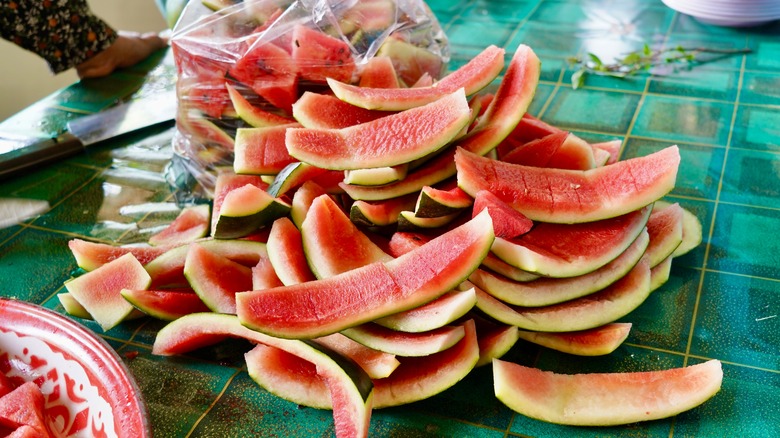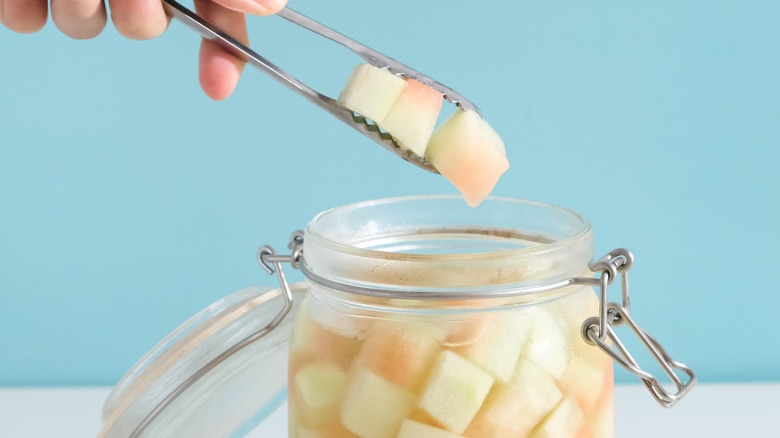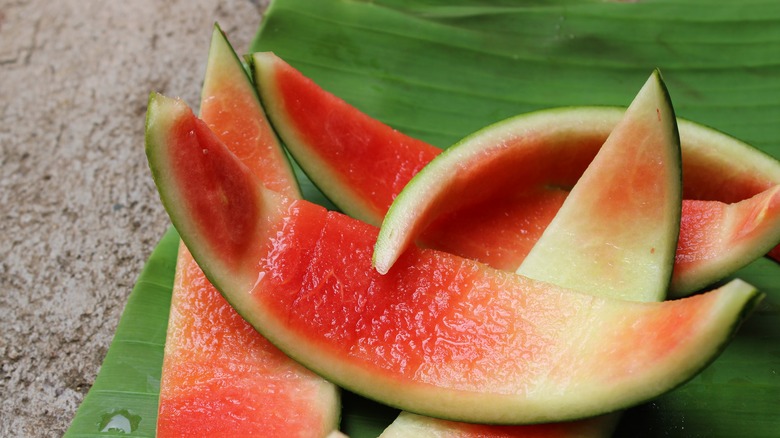Are Watermelon Rinds Edible?
Whether you're cutting watermelon into sticks, wedges, or cubes for a watermelon feta salad, the crunchy green and white rind often gets left behind on plates or the cutting board. Forlorn, forgotten, and destined for the trash can or (if they're lucky) the backyard compost pile, the rinds of watermelon are rarely appreciated. If the thought of these lonely watermelon rinds doesn't move you, consider this, the rind makes up about 30% of a watermelon, meaning that throwing it away is leading to some serious food waste.
But, we have news for you –– this often discarded food is not only edible, but quite delicious. With just a bit of culinary finesse, watermelon rinds can be transformed into a variety of dishes. This means using the rind helps won't just cut down on food waste, but offer a few nutritional benefits as well. In addition to the natural hydration they provide, they're also a great source of dietary fiber.
Eating watermelon rinds (and other peels) isn't new
If they're edible, where did we get the idea to throw away watermelon rinds instead of eating them? It may have something to do with rinds being less sweet and juicy and more hard and fibrous; but for the same reason we boil potatoes instead of munching on them raw, you can soften those tougher portions. Around the world, people enjoy watermelon rinds in many creative preparations. In both India and the American South, watermelon rinds are commonly pickled, as their flavor fairly neutral flavor profile is versatile enough to be taken in sweet, savory, or sour directions.
Watermelon rinds are also right at home in savory dishes like Chinese stir-fry recipes, south Asian curries, or tangy fermented kimchi. To bring out their sweet notes, watermelon rinds can be added as-is to smoothies or juices. With a bit of sugar, they can also be turned into chewy watermelon candy or spreadable jam.
If you're still not convinced to try watermelon rinds, consider all of the other edible skins and peels in the fruit and veggie world. Aside from the obvious picks like apples and pears, you can also eat the skin of kiwis, papayas, mangos, carrots, and potatoes. Don't get too carried away though. Some tough exteriors aren't meant to be eaten, including pineapples, lychees, and avocados.
Cutting food waste isn't the only reason to eat rinds
Now that we've normalized eating the skins and rinds of certain fruits and vegetables and established that it's a good way to waste less watermelon, it's worth mentioning another valid reason to eat the rind — nutrition. Aside from being 95% water (unsurprisingly) they also provide a bit of fiber.
Notably, watermelon rinds contain l-citrulline, an amino acid that by some measures is more concentrated here than in watermelon flesh. Citrulline can be converted to another amino acid, arginine, which helps make proteins and produce nitric oxide, which plays a role in circulation. This cascade is why citrulline gets a lot of attention for its heart health and athletic performance potential.
For example, one small study published in the Journal of Applied Physiology showed that six grams of l-citrulline daily improved blood pressure and exercise performance in a group of adults doing cycling exercise. However, more studies are needed to confirm these findings and you'd have to eat a lot of watermelon rind to get six grams of citrulline.
Researchers have estimated that there is about 1.3 milligrams of citrulline for every gram of fresh watermelon rind and 28.5 milligrams for every gram of dried. That means you'd need to eat over 10 pounds of fresh watermelon rind or half a pound of dried rind to reach a therapeutic level. Regardless, it's reassuring to know that you no longer have to throw away those rinds.


